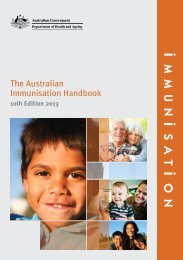Contents Chapter Topic Page Neonatology Respiratory Cardiology
Contents Chapter Topic Page Neonatology Respiratory Cardiology
Contents Chapter Topic Page Neonatology Respiratory Cardiology
Create successful ePaper yourself
Turn your PDF publications into a flip-book with our unique Google optimized e-Paper software.
F. Prognosis<br />
a) Apgar score and mortality.<br />
Mortality in the first year of life for premature babies.<br />
Babies < 2500g : mortality > 80% if Apgar is 0 - 3 at 15 min.<br />
mortality > 95% if Apgar is 0 - 3 at 20 min.<br />
Babies > 2500 g: mortality is 50% if Apgar is 0 - 3 at 15 min.<br />
mortality is 60% if Apgar 0 - 3 at 20 min.<br />
Mortality very high in infants who do not breathe spontaneously at 30 min.<br />
Risk of CP. is 60% for BW > 2500 g if Apgar is 0 - 3 at 20 min.<br />
93% of babies with Apgar 0 at 1 min. and 0-3 at 5 min. were entirely normal<br />
on follow-up. Therefore 15 min and 20 min score is important.<br />
b) Severity of HIE and outcome (most accurate predictor)<br />
No infant with mild HIE alone developed impairment. Mild encephalopathy<br />
carries an excellent prognosis irrespective of Apgar score and parents<br />
should be strongly reassured of excellent outcome.<br />
The median risk for impairment is 25% in moderate NE and 92% in severe<br />
NE.<br />
c) CT scans done after 1st week of life.<br />
Extensive areas of low attenuation with apparent brightness of basal ganglia<br />
are associated with very poor prognosis.<br />
d) Doppler U/S appears to be an accurate predictor for full term babies done after 24<br />
hours of life.<br />
Decrease Pourcelot’s resistivity index (PRI 3 SD of the<br />
normal mean has a +ve predictive value for adverse outcome of 94%.<br />
e) U/S of head can be done at discharge and at 2 - 3 weeks of life to look for<br />
periventricular haemorrhage or periventricular leukomalacia.<br />
f) EEG:<br />
severe abnormalities include burst suppression, low voltage or isoelectric EEG.<br />
moderate abnormalities include slow activity<br />
The overall risks for death or disability were 95% for severely abnormal EEG,<br />
64% for moderately abnormal EEG and 3 % for normal or mildly abnormal EEG 7,8<br />
Continuous EEG monitoring in the first 6-12 hours after birth has been shown to<br />
identify infants at risk of subsequent brain damage 9<br />
Long term :<br />
a. Phenobarbitone will be taken off on discharge if the child is neurologically normal<br />
and feeds normally (by day 7-10).<br />
b. If CNS is abnormal - the duration of phenobarbitone use is controversial.<br />
Probably 3-6 mths. (Longer if EEG abnormal)
















